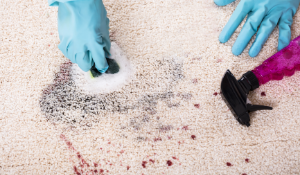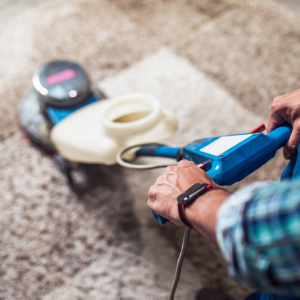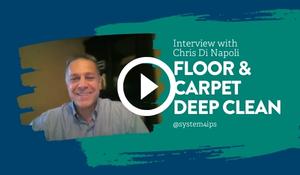Spots, Stains and Spills - 9 Tips


With carpeting making up 41% of all floor coverings sold in 2019 according to Floor Covering Weekly it's no wonder we are frequently asked about spots, stains and spills. System4 IPS has the know-how and professionals to spiff up your image and help you make the best first impression.
 Flooring and carpeting take up a huge amount of visual real estate in your workplace. Are spots, spills and stains taking the spotlight? They are often the first thing visitors notice about your floor coverings. Left untreated, spots and stains on carpets have the potential to create a negative impression of your business, school or commercial building. However, an early response can help reduce the incidence of permanent blemishes and keep your facility carpet looking fresh and clean no matter what life throws (or drops) at it!
Flooring and carpeting take up a huge amount of visual real estate in your workplace. Are spots, spills and stains taking the spotlight? They are often the first thing visitors notice about your floor coverings. Left untreated, spots and stains on carpets have the potential to create a negative impression of your business, school or commercial building. However, an early response can help reduce the incidence of permanent blemishes and keep your facility carpet looking fresh and clean no matter what life throws (or drops) at it!
Spot versus Stain
 The difference between a spot and a stain is about 24 hours, according to CleanLink. A more scientific definition between them involves whether or not texture is added to the fibers or not. A stain becomes part of the filament. Treated quickly, spots and spills are easier to clean. But if a spot sits and becomes a stain it will be more challenging to remove and likely to become permanent
The difference between a spot and a stain is about 24 hours, according to CleanLink. A more scientific definition between them involves whether or not texture is added to the fibers or not. A stain becomes part of the filament. Treated quickly, spots and spills are easier to clean. But if a spot sits and becomes a stain it will be more challenging to remove and likely to become permanent
Understand and Identify - water or oil based? What kind of fibers?
 Knowing or identifying the culprit is the first step towards removing it safely and properly. If the spot or stain is crusty or contains debris, it could be organic matter or water-based. If its appearance is shiny, it may be oil based. Water-based stains are easier to remove, while oil-based issues can require more effort and even professional help. Having a list of common oil or water based stains posted in your workplace can staff identify and report the problem to your maintenance team. Whether it's high traffic carpeting in a commercial environment, or plush residential carpeting in a home, Popular Mechanics and other professionals at Superclean Carpet & Flood Restoration, have tried and true methods to share.
Knowing or identifying the culprit is the first step towards removing it safely and properly. If the spot or stain is crusty or contains debris, it could be organic matter or water-based. If its appearance is shiny, it may be oil based. Water-based stains are easier to remove, while oil-based issues can require more effort and even professional help. Having a list of common oil or water based stains posted in your workplace can staff identify and report the problem to your maintenance team. Whether it's high traffic carpeting in a commercial environment, or plush residential carpeting in a home, Popular Mechanics and other professionals at Superclean Carpet & Flood Restoration, have tried and true methods to share.
 Figuring out exactly what kind of fibers you're working with can ensure the right product is chosen. Many updates and changes have been made recently thanks to carpeting manufacturers innovations. Here's a helpful guide from ISSA that defines the varying types of carpet fibers and the facts about how to care for them.
Figuring out exactly what kind of fibers you're working with can ensure the right product is chosen. Many updates and changes have been made recently thanks to carpeting manufacturers innovations. Here's a helpful guide from ISSA that defines the varying types of carpet fibers and the facts about how to care for them.
What to Do?
Many professionals are leaning towards hydrogen peroxide for general purpose spotting. It's biggest benefit is not leaving any residue, which can act as a magnet and lead to resoiling.
While hydrogen peroxide is effective for tannin stains, such as coffee and tea, it won’t work on grease or oil-based stains; therefore, a good spotting kit should also contain a grease, oil and paint remover. Additionally, professionals recommend an enzyme-based cleaner to remove organic stains, such as food, urine and blood, as well as a red dye remover for wine and red-based juice stains. Spot removal kits should also contain a stiff nylon brush to tamp the solution into the carpet and white terrycloth towels for blotting.
9 Tips for Removing Stains
-
Fast Response - The longer the stain is allowed to remain, the more chance it has to set.
-
Identify - Determine what kind of stain you are working and the type of fabric or surface it is on so you can choose the best solution to resolve it. Is it oil-based or water-based? See below for reference chart.
-
Blot - Remove as much excess stain as you can via
 blotting with an absorbent material, scraping or brushing whatever will come off. DO NOT rub it in.
blotting with an absorbent material, scraping or brushing whatever will come off. DO NOT rub it in. -
Test - Test all fabrics and carpets before cleaning by spraying a small amount of your chosen spot remover product on a hidden area, blot dry and observe for 10 minutes. Make sure no color transfers onto your white cleaning cloth. When dry, there should not be a visible discoloration in the area you cleaned.
-
Periphery - Begin your work from the outside edge of the stain to the inside to keep the stain from spreading.
-
Time - Let treatment chemical sit a few minutes, then blot. Change cleaning cloths if they become saturated to avoid spreading the stain into the surrounding area.
-
Blot Again - After treating, lightly spray-rinse the area with clean water to remove any residual chemical. Then blot again. If chemicals are not completely removed they can easily attract new dirt later and cause resoiling.
-
Wick and Weight -To help prevent stain reappearance, place a dry cloth or paper towel and a weighted object on top of the stain and leave it overnight. Stains that have penetrated to the lower sections of carpet fibers or the pad should “wick” up the fiber and into the dry cloths.
-
Call System4 IPS for expert spot & stain removal if these efforts do not work.
Water Based Stains
| Ammonia | Dye* | Liquor |
| Beer | Egg | Milk |
| Beetroot* | Excrement | Soft Drinks |
| Berries* | Food Coloring* | Soy Sauce* |
| Blood | Fruit Juices | Spackle |
| Butter | Glue (wet) | Starch |
| Candy | Grass | Tea* |
| Cheese | Grout (wet) | Toothpaste |
| Chocolate | Ice Cream | Urine* |
| Coffee* | Ketchup | Vomit* |
| Cough Syrup* | Lard | Wine* |
| Curry* | Latex Paint (wet) |
Oil Based Stains
| Adhesive Tape | Hand Lotion | Nail Polish* |
| Butter | Ink* | Ointment |
| Candy | Lamp Oil | Paint |
| Caulk | Linseed Oil | Playdough |
| Cooking Oil | Lard | Putty |
| Crayon | Lotion | Rubber Cement |
| Dressing (salad) | Machine Oil | Shoe Polish |
| Furniture Polish* | Make Up | Soot |
| Glue | Marker | Tar |
| Grease | Mascara | Tree Sap |
| Gum | Mayonaise | Vaseline |
| Hair Oil | Metal Polish |
*These items can chemically damage carpet fibers which may require a professional's assistance. Please be EXTREMELY careful with ink. For larger spills call 800-674-9412 to find your local System4 IPS representative.
How Often Should You Check for Spots or Stains
Commercial carpeting is a big investment. You can help prolong its life cycle and keep it looking attractive by treating and cleaning spots and stains as quickly as they are noticed. Checking for them daily should be a routine aspect of your maintenance program; System4 IPS recommends the following:

It’s important to have a wide variety of chemicals in your cleaning arsenal for when accidents strike. When using chemicals, always follow the manufacturer instructions to help prevent stain reappearance and to ensure you are handling the product safely. If you are concerned about whether you are using the right chemical for your carpet cleaning needs or using the proper equipment for a periodic deep cleaning, then consult System4 IPS.
According to Zippia, the carpet cleaner workforce reached a whopping 29,006 in 2020! Plus, Statistica says the carpet cleaning industry is growing at a rate of almost 3%. With so many professionals to choose from, which team is right for you? System4 IPS specializes in creating customized janitorial programs that meet the unique need of businesses just like yours!
 If you have experienced a COVID-19 singular case or outbreak amongst your staff or at your facility, call System4 IPS and schedule your disinfection service today. Our team listens to your needs, requirements, and timing. See our many satisfied customer testimonials and public Google ratings.
If you have experienced a COVID-19 singular case or outbreak amongst your staff or at your facility, call System4 IPS and schedule your disinfection service today. Our team listens to your needs, requirements, and timing. See our many satisfied customer testimonials and public Google ratings.


